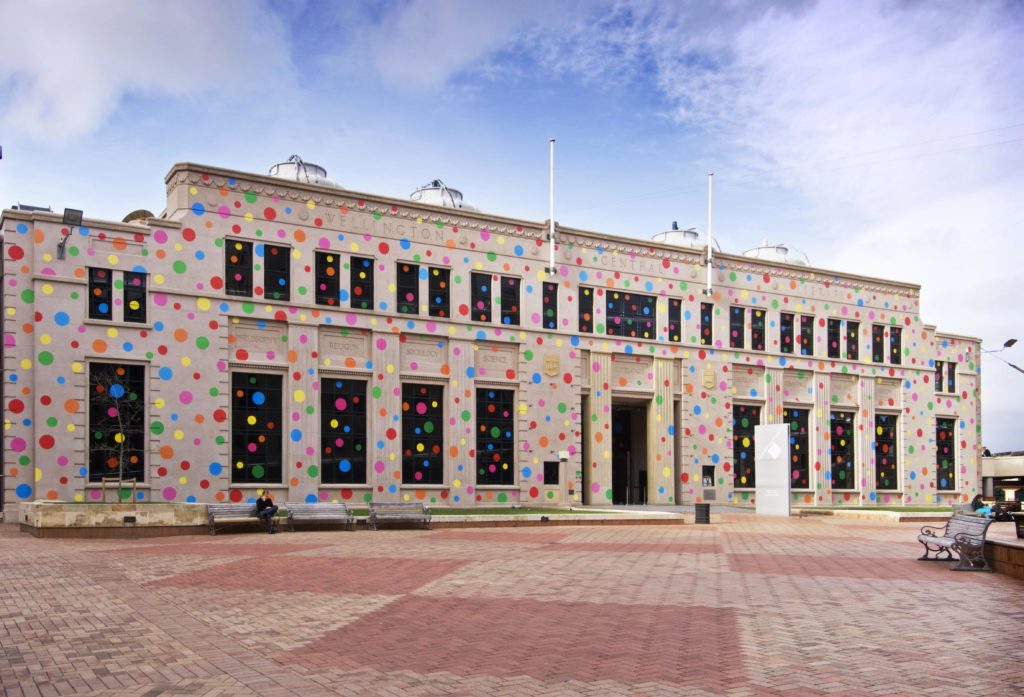CURATORS Jaap Guldemond (Museum Boijmans van Beuningen), Franck Gautherot (Le Consortium, Djon), Kim Seungduk (Le Consortium), with additional works selected by Paula Savage (City Gallery Wellington) and Judith Blackall (Museum of Contemporary Art, Sydney), and Kusama Studio, Tokyo PARTNERS Museum Boijmanns van Beuningen, Rotterdam; Museum of Contemporary Art, Sydney OTHER VENUES Museum Boijmans van Beuningen, 23 August–19 October 2008; Museum of Contemporary Art, 24 February–8 June 2009 PUBLICATION publisher Les Presses du Reel; essays Franck Gautherot, Jaap Guldemond, Seungduk Kim, Midori Yamamura, Diedrich Diederichsen, Lily van der Stokker
Celebratory. Cosmic. Pop. Following a $6.3 million building redevelopment, City Gallery reopens with Mirrored Years, a show by renowned Japanese artist, Yayoi Kusama.
Born in 1929, Kusama was an epoch-defining figure in the 1960s New York art world, where she vied with Andy Warhol for the status of most publicised artist. Her early career bridged abstract expressionism and pop. Inspired by vivid childhood hallucinations, she began making her Infinity Net paintings in 1958, covering canvases with fine networks of lines, leaving fields of dots. Kusama describes them ‘as without beginning, end, or centre’. The dots, which became her trademark, were simultaneously expressions of the universe and eternity and of self-obliteration.
In 1962, Kusama began building her mirrored Infinity Rooms—immersive, psychedelic installations suggesting endless space. In bacchanalian ‘happenings’, she painted dots on the bodies of naked participants, including herself, often to protest the Vietnam War. She also ran her own fashion label and boutique.
After returning to Japan in 1973, she launched a parallel literary career, publishing poems, novels, and an autobiography, also titled Infinity Net. A diagnosed obsessive compulsive, she checked into Tokyo’s Seiwa Hospital for the Mentally Ill in 1977, eventually taking up permanent residence there, while continuing to work from her nearby studio.
Kusama’s reputation has grown steadily. In 2008, Christies, New York, auctioned a 1960 Infinity Net painting—once owned by artist and critic Donald Judd—for $US7.1 million; then a record price for a living female artist. In 2016, Time magazine will include her in its annual list of ‘The 100 Most Influential People’ and Madame Tussauds, Hong Kong, will unveil a wax figure of her.
Mirrored Years arrives in Wellington after attracting record audiences at Sydney’s Museum of Contemporary Art. The title refers to Kusama’s enduring use of mirrors. The show includes paintings, prints, sculptures, installations, and films. On the first day, the queue loops around Civic Square.
Ground-breaking works from the 1960s and 1970s are shown alongside more recent installations. One key work is Narcissus Garden (1966), a collection of 1500 mirrored balls. Kusama originally installed it, uninvited, at the 1966 Venice Biennale. In a gold kimono, she began to sell the balls for 1,200 lire each, until the authorities closed her down. She was told it is not permitted ‘to sell art like hot dogs or ice cream cones at the Venice Biennale’.
Visitors line up to take their turn in Kusama’s legendary mirror-room installations, Infinity Mirror Room: Phalli’s Field (1965) and Fireflies on the Water (2000). Viewers enter Fireflies one at a time, through a controlled mirrored door. Inside, 160 coloured LEDs, suspended from the ceiling, reflect in mirrored walls. The viewer stands on a dock above the floor, which is covered in a pool of water, also reflecting the lights. Space becomes infinite—sublime. In Wellington, several mesmerised visitors step off the dock into the water, causing ripples in the local media. Director Paula Savage explains to the Dominion Post, ‘the gallery had not installed safety railings because it did not wish to alter the artwork. It would make New Zealand look very, very stupid in the art world.’
The show includes fifty new drawings by Kusama and a drawing she made when she was ten years old. There are also two polka-dotted rooms with matching polka-dotted inflatables, ‘the adult equivalent of a bouncy castle’. Dots Obsession: Night features yellow dots on black; Dots Obsession: Day black dots on yellow (both 2008).
New works are added for Wellington, including Dots for Love and Peace, where Kusama transforms the City Gallery’s fifty-two-metre heritage façade with her signature dots—making it pop. Kusama worked from a set of architectural drawings to create her detailed installation plan, specifying the colour, size, and placement of each dot. It is the first time the gallery’s exterior has been used for a temporary work.













































































